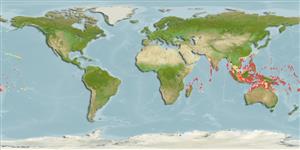Common names from other countries
Environment: milieu / climate zone / depth range / distribution range
экология
морской ассоциированный с рифами; немигрирующий; пределы глубины 0 - 40 m (Ref. 9710), usually 3 - 20 m (Ref. 37816). Tropical; 31°N - 20°S, 40°E - 148°W (Ref. 5222)
Indo-Pacific: East Africa (but not the Red Sea, Persian Gulf or South Africa) to the Society Islands, north to the Ryukyu Islands, south to northern Australia. Including most islands of the Indian Ocean and that of the west-central Pacific (Ref. 5222). Record from Rodriguez by Heemstra & Randall (1984, Ref. 3153) could not be verified and is probably erroneous (Ref. 33390).
Size / Вес / Возраст
Maturity: Lm ? range ? - ? cm
Max length : 24.0 cm TL самец/пол неопределен; (Ref. 9710); наибольший вес (опубликованные данные): 35.64 g (Ref. 124708)
колючие лучи спинного плавника (общее число) : 9; членистые (мягкие) лучи спинного плавника (общее число) : 13 - 15; колючие лучи анального плавника: 3; членистые (мягкие) лучи анального плавника: 9 - 10. Resembles C. urodeta, but always has a distinctive dark saddle on caudal peduncle (Ref. 37816); characterized further by reddish brown head with numerous red-orange or pinkish red spots, extending to pectoral region; mottled pinkish brown body; upper caudal-fin base with large dark brown saddle with smaller saddle just behind; upper part of caudal fin with dark brown streak, less intense streak on lower part; ctenoid scales on body including abdomen; greatest depth of body 2.6-2.9 in SL; rounded caudal fin; pelvic fins, 2.0-2.3 in head length (Ref. 90102).
Occurs in coral-rich areas of lagoon pinnacles, channels, and outer reef slopes. Solitary (Ref. 37816), a secretive species, usually hiding in caves and crevices in the reefs. One of the smallest species of groupers known. Omnivorous with diet composed of fishes and crustaceans; relatively low egg production per individual (Ref. 089707). Minimum depth reported taken from Ref. 128797.
Life cycle and mating behavior
Maturities | размножение | Spawnings | Egg(s) | Fecundities | личинки
Heemstra, P.C. and J.E. Randall, 1993. FAO Species Catalogue. Vol. 16. Groupers of the world (family Serranidae, subfamily Epinephelinae). An annotated and illustrated catalogue of the grouper, rockcod, hind, coral grouper and lyretail species known to date. Rome: FAO. FAO Fish. Synop. 125(16):382 p. (Ref. 5222)
Статус Красного Списка МСОП (Ref. 130435)
CITES (Ref. 128078)
Not Evaluated
Угроза для людей
Harmless
Использование человеком
рыболовство: не имеет хозяйственного значения
дополнительная информация
инструменты
Специальные отчеты
Скачать в формате XML
ресурсы в Интернет
Estimates based on models
Preferred temperature (Ref.
115969): 26.6 - 29, mean 28.1 (based on 550 cells).
Phylogenetic diversity index (Ref.
82804): PD
50 = 0.5000 [Uniqueness, from 0.5 = low to 2.0 = high].
Bayesian length-weight: a=0.01259 (0.00590 - 0.02687), b=3.04 (2.87 - 3.21), in cm Total Length, based on LWR estimates for this Genus-body shape (Ref.
93245).
Trophic level (Ref.
69278): 4.0 ±0.66 se; based on food items.
устойчивость к внешним воздействиям (Ref.
120179): высокий, минимальное время удвоения популяции до 15 месяцев (Preliminary K or Fecundity.).
Fishing Vulnerability (Ref.
59153): Low vulnerability (14 of 100).
